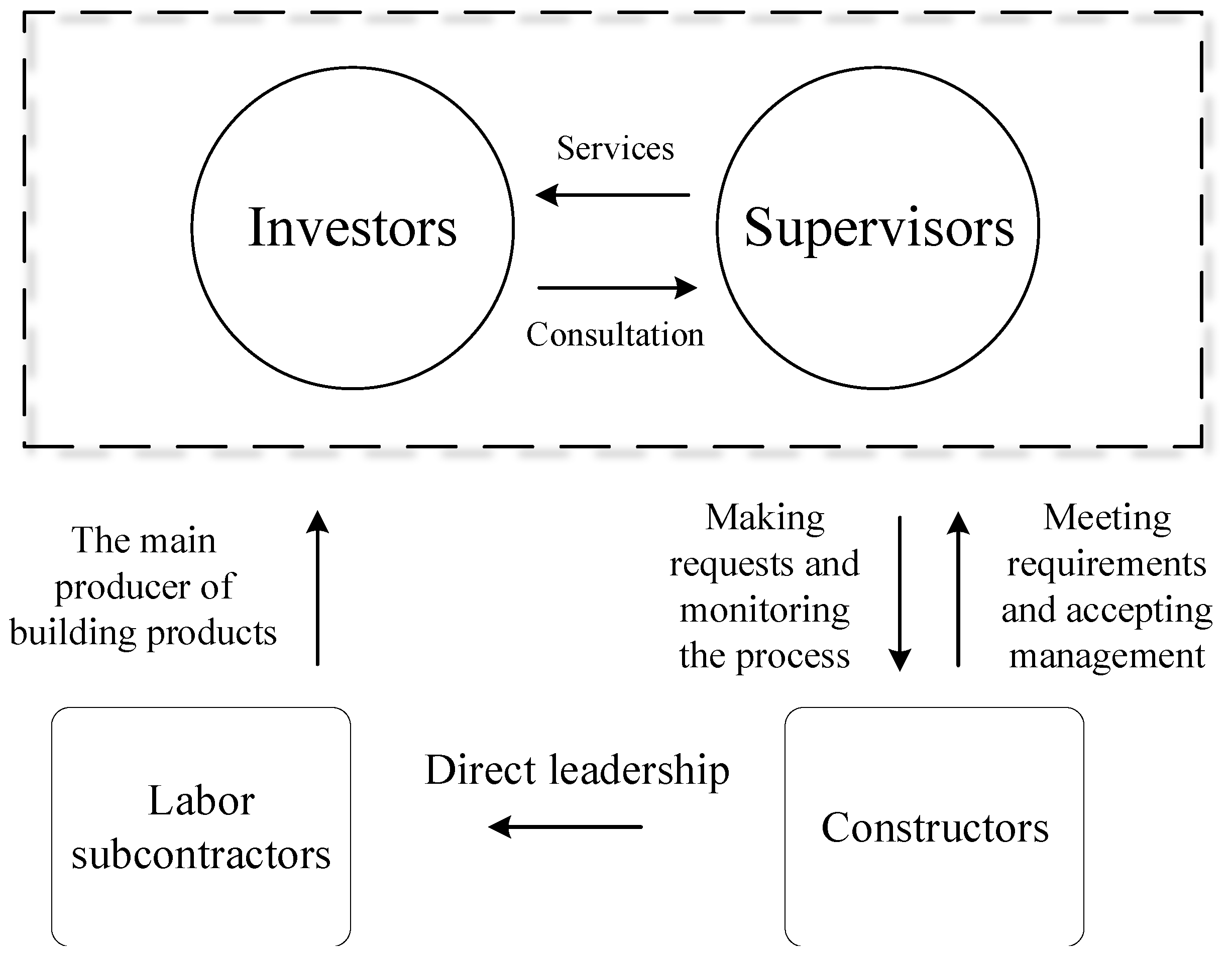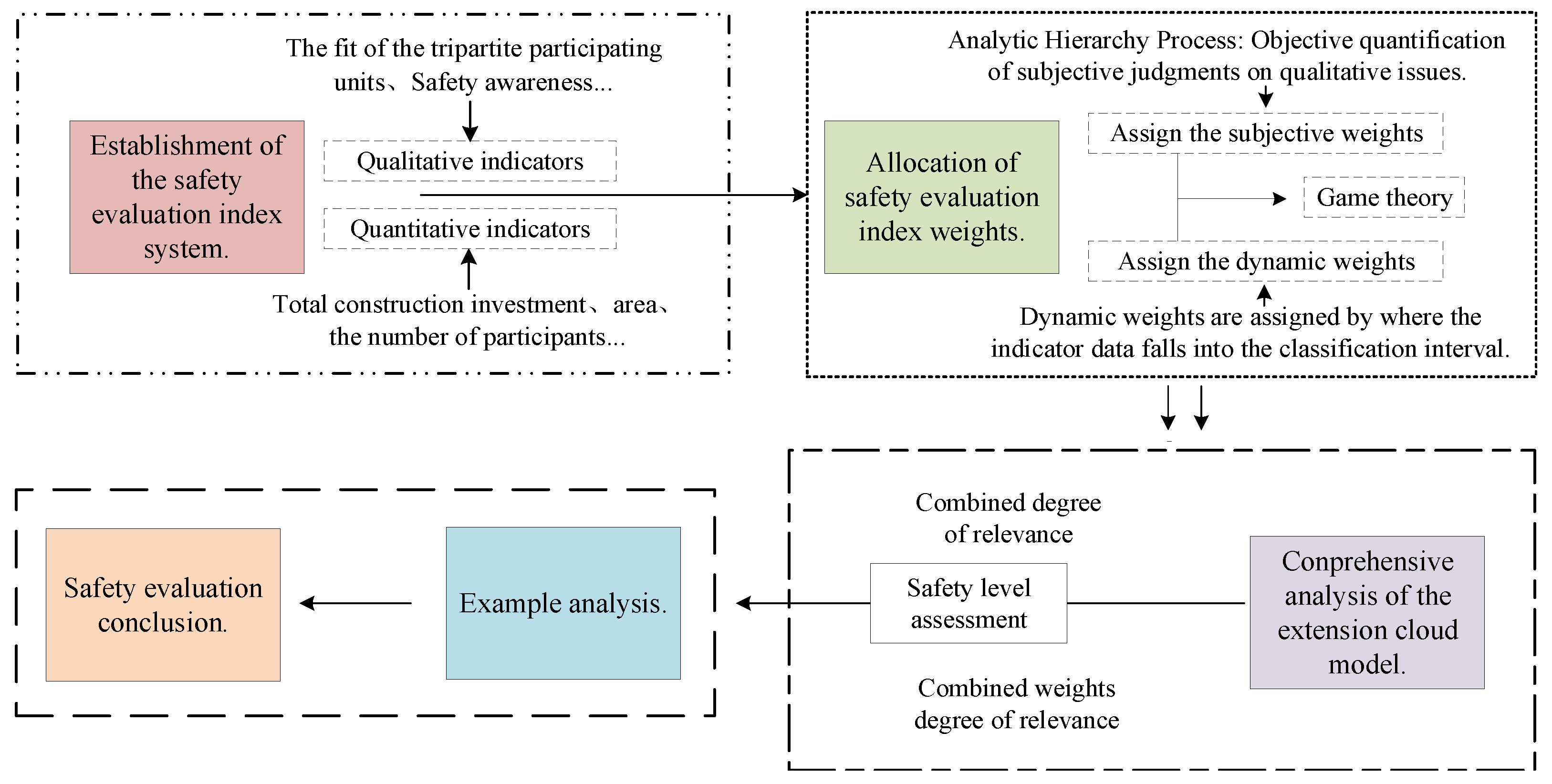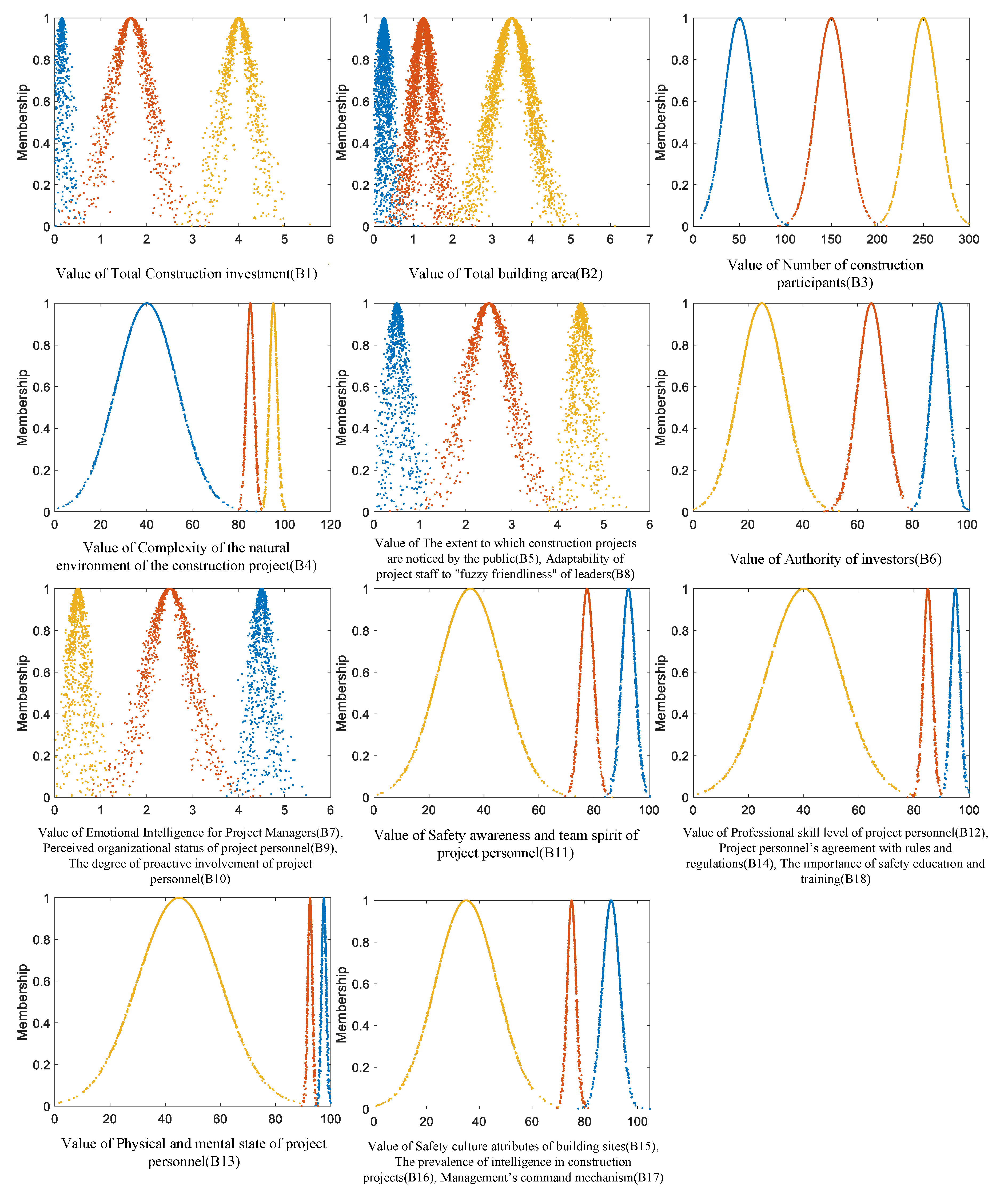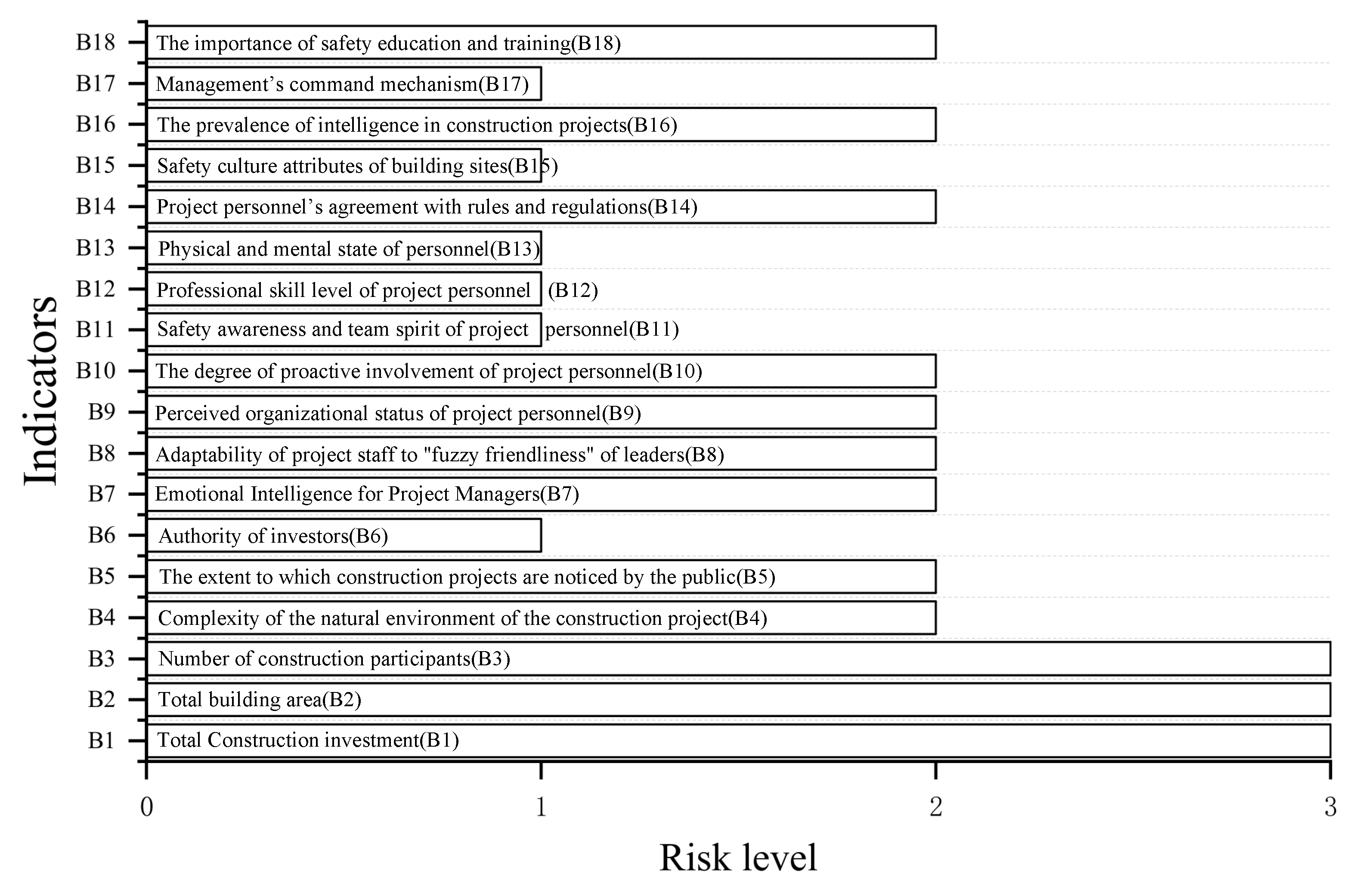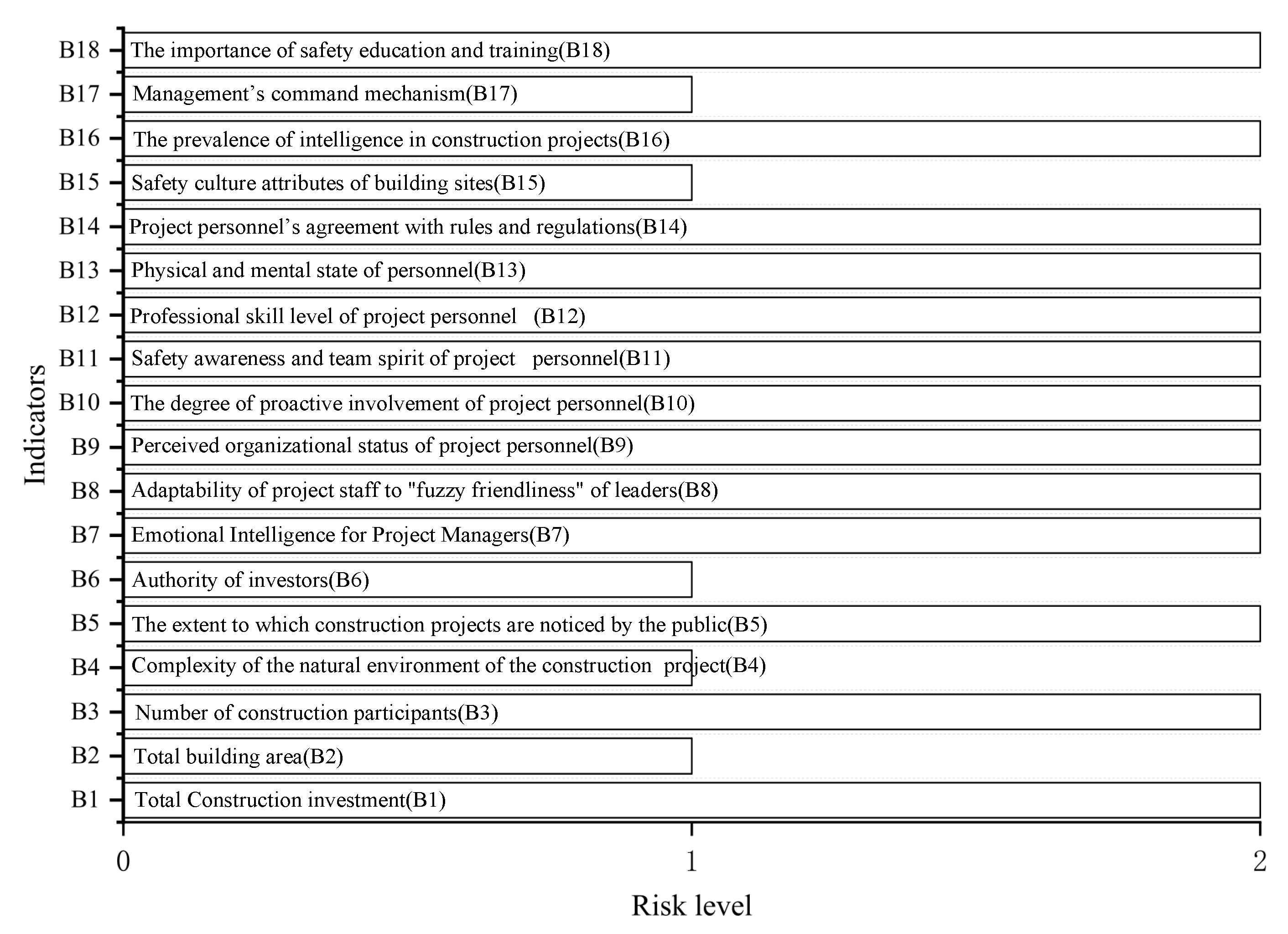2.1. Description of Safety Assessment Framework
The leader–member exchange ambivalence is experienced throughout construction projects and is reflected at each level of leadership. In this paper, the management of a construction project is partitioned into three levels—management of investors, management of constructors, and management of labor subcontractors. The investors refer to actual holders of construction projects after completion; they have absolute control over the construction projects. Investors’ management mainly includes the construction project management of the investment company and supervision unit that assists in the management. The constructors refer to the actual leading organization in the project’s construction process, which is formed temporarily and mainly appointed by a construction contractor; the leadership of the construction side mainly includes the top organizer (e.g., the project manager or chief technical person) who directs the construction process and the person in charge of all aspects of the construction site (construction technicians, safety supervisor, etc.); labor subcontractors refer to various types of skilled labor personnel that exist in the construction site; management of labor subcontractors mainly includes various types of skilled laborers. Management of the labor subcontractor mainly includes foremen, intermediaries of technical outsourcing, etc.
A perfect construction project requires participation from several specialized agencies; in addition to the three parties proposed above, there is also the participation of survey units, design units, rental units, suppliers of various materials, etc. However, during the construction process, these units cannot stay on the construction site for a long time, and they do not have much influence from the point of view of the leader–member exchange ambivalence affecting the safety performance of the construction site. Therefore, these units are not included in this paper.
In general, investors, as ultimate controllers of projects, have the highest leadership, but their expertise is weak; the investors may be unable to give comprehensive and accurate guidance by relying more on the advice from consultants and supervisors who manage the project. It is common that the expertise of investors is not commensurate with the power they hold [
26]. The result of this phenomenon is that the subjective belief from construction and labor subcontractors, i.e., that they will satisfy investors, often produces very different results.
The constructors, as actual leaders of construction processes of construction projects, are extremely reliable in their expertise but are subject to the management of investors in every way [
27]. When investors rely too much on supervisors, constructors even need to show very ambiguous attitudes toward supervisors. In this case, unclear superior–subordinate relationships between constructors and supervisors can be conflicting. On the one hand, they need to be on the same side as supervisors to obtain support for their work; on the other hand, they are afraid of not being able to communicate their true attitudes to investors through supervisors, thus creating negative work input.
For a long time, labor subcontractors have been the most indispensable party in construction projects, but they have to follow the direction of constructors and investors in terms of project decision-making. With the spread of education for all in China and the standardization of the construction industry, the quality of China’s construction workers has further improved and their individuality and construction involvement have been met [
28], giving them a place in project decision-making.
The tripartite relationship is complex and intertwined with management styles. The tripartite relationship is depicted in
Figure 1. The blurring of superior–subordinate relationships and mismatches between expertise and executive authority both deepen the intensity of the ambivalence generated. The results of ambivalent experiences are often negative, especially in the area of safety performance, which is the most worrisome aspect of construction projects. For example, constructors fear that the construction process will be deliberately “nitpicked” by a supervisor, so they deliberately avoid the supervisors in some sensitive construction parts and work quickly, which causes safety hazards. In addition, some workers, relying on their good relationships with constructors, do not comply with the safety systems and disrupt the safety atmosphere, which results in serious safety accidents.
A clear organizational structure with well-defined rules and regulations is one of the effective means to reduce the leader–member exchange ambivalence [
29], but this ambivalence is difficult to erase completely. The leader–member exchange ambivalence is an implicit factor that cannot be precisely described using a single indicator. In order to more precisely resolve the uncertainty and ambiguity of each party’s psychological state, this paper establishes an evaluation system to profile the leader–member exchange ambivalence through some easily accessible explicit indicators. This paper proposes a cloud model-based conventional safety evaluation method under the influence of the psychological state of the construction site based on the cloud model theory of qualitative and quantitative uncertainty transformation.
The research methodological framework of this paper is as follows: (1) Establishment of the safety evaluation index system. (2) Allocation of safety evaluation index weights. (3) Comprehensive analysis of the extension cloud model. (4) Example analysis. (5) Safety evaluation conclusion. The specific research method framework is shown in
Figure 2.
2.2. Safety Evaluation Index System
The situations of construction sites are extremely complex; coordinated operations involving multiple heavy types of machinery, construction tools, and a large number of workers endow leaders with great management difficulties, but states exhibited by different types of construction sites can vary greatly, and situations of construction sites are the results of interactions between multiple factors. Therefore, analyzing the influential indicators affecting the management decisions of leadership in construction sites and exploring reasonable key factors are prerequisites for establishing evaluation systems featuring safety performances of construction projects under the influence of psychological states.
The establishment of an evaluation index system, a specific analysis for specific problems, and a combination of quantitative and qualitative analyses need to be targeted. The selection of indicators also adopts the idea of a hierarchical analysis to rank problems and decompose the goals of the safety performances of construction projects under the influences of psychological states. In this paper, the evaluation system of the safety performance of a construction project under the influence of a psychological state was constructed from three perspectives—building scale, emotional orientation, and stability factors—and was decomposed into eighteen specific indicators. These indicators were extracted through relevant Chinese construction industry codes, existing literature, expert discussions, two project managers, three senior engineers, two experts engaged in research in this field, and three construction technicians who were invited for collaborative discussions. The Delphi method was used to invite scholars or experts in the field to determine and evaluate the indicators to be used. The information on the participants is shown in
Table 1. The facilitator summarized the report and discussed the applicability of these assessment indicators. Afterward, the facilitator provided feedback to the experts and repeated this operation until an agreement was reached. The evaluation index system is shown in
Table 2. Specific indicators are analyzed as follows.
(1) Building scale:
The scale of the construction project is the basis for all operations within the project. As the scale increases, so do the influencing factors that ensure the proper functioning of the construction projects. In addition to the basic conditions of the number of participants (
), amount of investment (
), floor area (
), and built environment (
), the factor of social opinion (
) received more attention after the outbreak of COVID-19 [
30]. Now, with an explosion of information, information about a construction project that receives attention is quickly disseminated to all parts of society via the internet, such as the construction processes of Huoshenshan and Leishenshan hospitals [
31,
32]. Social opinions magnify the behaviors of employees, and operations that conform to high-quality specifications will be praised by the public; the opposite will be indelibly shamed. There is also a great deal of psychological pressure on employees to be more compliant with the rules [
33]. Many studies have demonstrated that suppressing unsafe behavior can be effective in improving safety performance [
34,
35,
36], and social opinions can serve as effective external factors to influence safety performances.
(2) Emotional orientation:
It is infrequent for construction projects to receive such widespread attention. Safety management boils down to promoting synergy [
37]. Relationships between people change over the course of the collaboration, but perceptions generated by initial contacts have huge impacts on the outcome [
38]. This paper divides management into three categories (investor, constructor, and labor subcontractor) and further connects them in a refined analysis, expanding into the relationship between investor and constructor, connection with the constructor, and fitting between first-line managers and labor subcontractors. The investor, as the top leader, has great authority (
), but because the investor’s main business is generally not construction, the investor’s construction expertise is weaker. The investor easily forgoes dictating the building site restrictions [
39]. As the leader of the construction process, the project manager’s emotional intelligence (
) is a guarantee of the coordinated operation involving all departments [
40]. The ambiguous intimacy (
) of the leadership is the root cause of the leader–member ambivalence; subordinates do not adequately have a united front with the leader and tend to take conservative or even stagnant approaches to performing their tasks [
4]. Dechawatanapaisal [
41] proposed that employees’ ambivalence has a direct impact on career commitment. Wu et al. [
42] revealed that employees tend to adopt compromised approaches whether actively coping or passively avoiding such ambiguous intimacies. Ambiguous intimacy imposes a huge psychological burden on employees, making them walk on thin ice in work processes [
43]. Employees’ perceived organizational statuses (
) [
44] and proactive behaviors (
) [
45] are two complementary factors influenced by overall security climate, representing employees’ perceived statuses and involvement in the building organizations as a whole.
(3) Stability factors:
The cornerstone of stable organizational relations lies in management mechanisms (
) [
46]. Management mechanisms represent the resistance of the construction project to internal and external shocks. There are many factors to consider when carrying out a construction project, such as geological environment, risk sources, and human relations. The management system of a construction site can clarify the responsibilities of the project’s employees, and the safety culture (
) (
) of a company can influence the work engagement of the employees (
) [
47]. With the gradual improvement of the informationization of modern construction projects, the role of intelligence has also come to the fore (
) [
48,
49]. Similar to the influences of social opinions of employees, the use of intelligence promotes transparency and informatization on construction sites, where employees’ unsafe behaviors can be monitored and stopped in a timely manner, which could increase safety awareness.
2.3. Cloud Model
Ambiguity and randomness are reflected in all aspects of human history, and the uncertainties they represent make it impossible to describe things precisely. For this reason, in 1995, Li Deyi, a member of the Chinese Academy of Engineering, proposed a concept of a cloud model to describe mathematically objective laws of this uncertainty phenomenon [
50]. The pervasiveness of the cloud model has been widely demonstrated and has been extended to many domains [
51,
52,
53]. In the field of construction engineering, cloud models were mainly used in safety risk evaluations, such as in the evaluation of construction site safety system resilience assessments [
54] and comprehensive safety evaluations of building construction sites [
55].
The cloud represents conversion and uncertainty mapping between qualitative and quantitative factors. The numerical characteristics of the cloud mainly consist of the expectation value , entropy value , and hyper-entropy . is a central value of the cloud, which indicates the grade interval or average value of cloud droplets; the safety performances of construction projects under the influence of psychological states are based on this value; the entropy value reflects the sizes of the span of clouds and discrete degrees of cloud drops, a larger indicates greater randomness of the evaluation index and greater ambiguity of the grading boundary; hyper-entropy is an entropy uncertainty measure, reflecting the thickness of the cloud layer. In order to reduce various ambiguities and uncertainties in the process of the safety evaluation under the influence of the mental state, the cloud correlation model was constructed by using the expectation value , entropy value , and hyper-entropy .
In 1983, Professor Cai Wen proposed topology, also known as matter–element analysis, as a system of methods to reveal the inner laws of contradictory problems and to solve contradictory problems under restrictive conditions [
56]. The basic unit of topology is matter–element, and the basic model of matter–element is an ordered triple
R = (name of problem, characteristic of problem, value taken of the characteristic) = (
N,
C,
V).
N,
C, and
V are three elements of matter–element, and
V is usually a definite value or interval. The eigenvalue
V of the matter–element analysis model is usually a definite value. By combining the cloud model with the matter–element analysis and taking advantage of fuzziness and randomness of the cloud model, (
,
,
) is used instead of
V to construct a topological cloud model for the safety performances of construction projects under the influences of psychological states; these were qualitatively and quantitatively synthesized and evaluated, and uncertainties of the evaluations were considered. The specific mathematical model is shown below.
If there are
m evaluation indicators for the matter–element to be evaluated, i.e.,
,
, ⋯
, and each indicator has
n evaluation levels, then the
m-dimensional matter–element is:
The matter–element extension cloud model can be expressed as:
According to a large number of existing research results on construction project safety evaluations [
54,
55], relevant laws and regulations, as well as discussion results from experts, this paper divides the safety performances of construction projects under the influences of psychological states into three levels and determines the evaluation criteria of each level within the index system. Since the largest number of small- and medium-sized construction projects exist in China, when universally considering, an upper limit is set for the investment (
), area (
), and number of participants (
), in addition to referring to the relevant Chinese industry standards. There are many qualitative indicators in this system, and these indicators are evaluated in two ways in this paper—grade evaluation and score evaluation. The grade is divided into 1–5 levels; a higher grade means a stronger degree of performance of the index content; the score range is [0,100]. Numerical characteristics of the cloud are key to evaluate the model. Each indicator of the classification level has a value interval (
,
), and three elements of the standard cloud model (expected value, entropy, and hyper-entropy) are calculated using Equations (3)–(5). According to the evaluation method of the standard cloud model, the extension cloud matter–element model can be further constructed. Among them,
s is denoted as a constant, which is set by the uncertainty of each indicator and actual situation; in this paper, considering the characteristics of each indicator, the constant value of
s is set to 0.1 [
55]. The cloud diagram is shown in
Figure 3. The specific numerical divisions are shown in
Table 3.
2.4. Assignment of Subjective Weights
The analytic hierarchy process (AHP) is a decision-making method that decomposes elements that are relevant for decision-making into, e.g., objectives, criteria, and solutions, where qualitative and quantitative analyses are performed [
57]. The subjective weights of the indicators are calculated by analyzing and comparing each indicator based on expert experience. The calculation steps of the analytic hierarchy process are as follows:
Step 1: Decompose the hierarchy of the target problem and construct the judgment matrix within each level. The judgment matrix of each level is constructed according to the “1 to 9” ratio scale proposed in the literature [
58]. The results are expressed using
, which represents the comparison between factor
i and factor
j in terms of importance, expressed in a formula as the following:
. The quantitative representation of the importance is shown in
Table 4.
Step 2: Calculate the maximum eigenvalue (
) of the matrix. The consistency test is performed by following equations. The consistency of the matrix is checked by the consistency ratio (
) to see if the consistency of the matrix meets the requirements. When
, the consistency of the pairwise comparison matrix is judged to pass the requirements. The values of the average random consistency index
are shown in
Table 5.
The above steps allow subjectivity calculating the weights of the safety performances of the construction projects under the influences of psychological states (for each indicator), as shown in
Table 6.
2.6. Combined Weighting Calculation
In order to avoid the single-weight evaluation method from being too different from the actual situation, the game theory method is introduced to combine multiple weighting methods into a more reasonable weighting model. The implementation steps for combining weights are shown below:
Step 1: It is assumed that the model uses an
x-group weighting approach (two in this paper), with each group of weight vectors denoted as
, and linear combination coefficients as
. The combination is performed according to Equation (
12):
Step 2: According to the optimal strategy, minimize the deviation between
W and
to find the smallest
, as shown in Equation (
13):
The conditions for obtaining the optimal first-order derivative after the derivative of the matrix are given in Equation (
14):
Step 3: Normalizing according to Equation (
15), combined weights can be obtained by Equation (
16):
2.7. Safety Level Measurement
The cloud model consists of cloud droplets, and the security level of the cloud model is determined according to the maximum affiliation principle. The affiliation degree of cloud droplet
x in the standard cloud model is calculated by Equation (
17):
The correlation matrix is denoted as
D, where
, and
are the correlations between indicator
i and level
j.
The combined evaluation vector
B can be obtained by combining the weight vector with the correlation matrix:
The value of the composite judging index
r can be obtained by the weighted average method:
where
is a component of vector
B.
is the value of the evaluation level (1: low; 2: medium; 3: high).
Since
is randomly generated when solving the cloud correlation degree
k, and
is also random in nature, multiple solving is required to reduce the effect of randomness on the evaluation results. In this paper,
.
The credibility
is inversely proportional to the confidence of results, with larger
and lower confidence.
